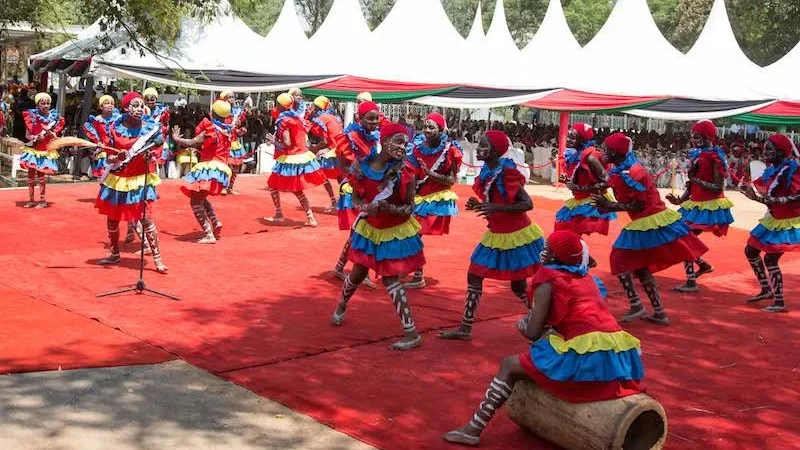Yo, let me take you on a journey to Nakuru School, tucked away in the Umoja Estate along the Nakuru-Nyandarua road. This place is a cultural wonderland that’ll blow your mind! They turned the whole campus into a vibrant showcase of East African heritage. We’re talking cultural music that’ll get your feet tapping, traditional dances that’ll leave you in awe, and oh boy, the local delicacies! You’ll be drooling, trust me.
The aim of this extravaganza was to preserve and promote our rich cultural heritage. They went all out and recreated traditional villages to give visitors a taste of the unique way of life of different ethnic tribes. It’s like stepping into a time machine, my friends. Each village showed off the communication tools, hunting techniques, storage facilities, and traditional utensils specific to their tribe. Talk about attention to detail!
They brought together an incredible assortment of ethnic groups from near and far. We had the Dinka from South Sudan, the Baganda from Uganda, and a whole bunch of Kenyan tribes like the Kikuyu, Somali, Maasai, Kalenjin, Kamba, Luhya, Mijikenda, Luo, Teso, Embu, Kisii, and the list goes on! These students from Uganda even caught the eye of a tourist from Germany. They gave her a full tour of the Baganda King’s Court, breaking down the significance of each hut and who gets to occupy them. Talk about being thorough!
Over 600 people, including our German visitor, roaming around in awe. They were checking out the stunning traditional furniture, the intricate ornaments, the sweet sounds of musical instruments, and the regal ceremonial outfits. Each item represented the unique identity of their community. It was a feast for the senses, my friends.
But wait, there’s more! This festival wasn’t just about showcasing artifacts and dances. They went all out with traditional medicines, mind-blowing visual arts, captivating plays, dramatic verses that gave you chills, mind-bending acrobatics, and even stand-up comedy that had everyone rolling on the floor with laughter. They covered all the bases, I tell you!
Tabitha Waitindi, the Director of Nakuru School, had a lot to say about this incredible Cultural Day. She saw it as a way to celebrate Kenya’s achievements and bring us together for the sake of national development. She loved seeing our different cultures mixing and mingling, appreciating each other and learning from our differences. That’s what it’s all about, right?
But she also had some concerns. She noticed that as modernity takes over, our cultural heritage is slowly fading away. It’s a shame, really. We’ve got all these amazing tribes with unique traditions, yet fewer and fewer manage to hold onto them. And you know what’s ironic? We have African educational institutions offering programs in foreign languages like Chinese, French, Italian, Spanish, and Arabic, while our local dialects are at risk of disappearing. Something’s not right there.
Ms. Waitindi had a suggestion, though. She thinks it’s high time we integrate cultural studies into the school curriculum, starting from primary all the way up to tertiary education. That way, we can promote unity, national cohesion, and economic progress. It’s a smart idea if you ask me!
Another person who shared their thoughts was Grace Namunyak, a parent. She was fed up with Westerners appropriating and patenting Kenyan cultural symbols like the kiondo or Maasai shuka. It’s like they don’t appreciate the value of our heritage. Ms. Namunyak stressed the need to protect our cultural legacy from the overwhelming influence of Western civilization. Let’s keep our treasures for our future generations, folks!
And you know who’s on the same page? Ms. Namachemo. She knows that our children play a vital role in preserving African culture. They’re the future of our society, after all. Culture shapes them in so many ways, from their emotions to their social skills, physical growth, and even language development. Ms. Namachemo wants social workers, child rights advocates, and everyone working with kids to understand how culture impacts their well-being, growth, and learning. Wise words, my friends.
Lastly, we’ve got Felicia Olando, a teacher at the school. She knows just how transformative cultural events can be. They bring students from different backgrounds together, helping them build friendships and appreciate the diverse dance styles or mouth-watering food prepared by folks from other communities. Ms. Olando believes that these events reveal aspects of people’s personalities that don’t always come out in academic subjects like math or physics. It’s a whole new level of connection, my friends!
According to Ms. Olando, when students from different communities unite, they start seeing each other as fellow Kenyans, Tanzanians, and Africans. They go beyond tribal boundaries and recognize the talents and contributions we all bring to the table. That’s the Africa we want to build, folks. A place where unity triumphs over tribalism, and we embrace the beauty of every community and country. And once those friendships are formed, they’re unbreakable bonds.
So let’s celebrate our cultural diversity, my friends. Let’s cherish our traditions, protect our heritage, and keep our unique identities alive. Kenya is a treasure trove of culture, and together we can make sure it stays that way. It’s time to embrace the beauty of our differences and create a future that’s united and full of endless possibilities.



Leave a Reply